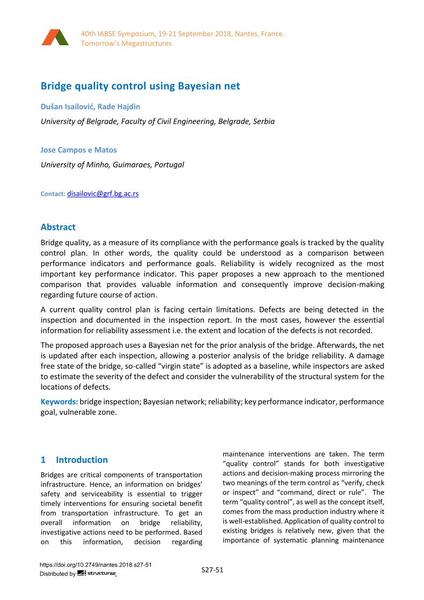Bridge quality control using Bayesian net

|
|
|||||||||||
Bibliographic Details
| Author(s): |
Dušan Isailović
(University of Belgrade, Faculty of Civil Engineering, Belgrade, Serbia)
Rade Hajdin José Campos e Matos (University of Minho, Guimaraes, Portugal) |
||||
|---|---|---|---|---|---|
| Medium: | conference paper | ||||
| Language(s): | English | ||||
| Conference: | IABSE Symposium: Tomorrow’s Megastructures, Nantes, France, 19-21 September 2018 | ||||
| Published in: | IABSE Symposium Nantes 2018 | ||||
|
|||||
| Page(s): | S27-51 | ||||
| Total no. of pages: | 8 | ||||
| DOI: | 10.2749/nantes.2018.s27-51 | ||||
| Abstract: |
Bridge quality, as a measure of its compliance with the performance goals is tracked by the quality control plan. In other words, the quality could be understood as a comparison between performance indicators and performance goals. Reliability is widely recognized as the most important key performance indicator. This paper proposes a new approach to the mentioned comparison that provides valuable information and consequently improve decision-making regarding future course of action. A current quality control plan is facing certain limitations. Defects are being detected in the inspection and documented in the inspection report. In the most cases, however the essential information for reliability assessment i.e. the extent and location of the defects is not recorded. The proposed approach uses a Bayesian net for the prior analysis of the bridge. Afterwards, the net is updated after each inspection, allowing a posterior analysis of the bridge reliability. A damage free state of the bridge, so-called “virgin state” is adopted as a baseline, while inspectors are asked to estimate the severity of the defect and consider the vulnerability of the structural system for the locations of defects. |
||||
| Keywords: |
reliability bridge Inspection Bayesian network key performance indicator performance goal vulnerable zone
|
||||
